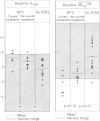Abstract
Forced oscillometry was used to investigate whether lung injury due to bronchopulmonary dysplasia in early life caused abnormalities in bronchial calibre or an increase in bronchial responsiveness to histamine at school age. Results were compared with data obtained from healthy children born prematurely and from healthy children born at term. There was a mild increase in frequency dependence of total respiratory resistance in children who suffered from lung injury in early life, which indicates uneven ventilation in peripheral airways. Bronchial responsiveness to histamine in these subjects was normal. No abnormalities were found in the control group. We conclude that lung injury in early life may cause residual abnormalities of peripheral airways. This does not happen in premature babies who do not have respiratory problems in the neonatal period.
Full text
PDF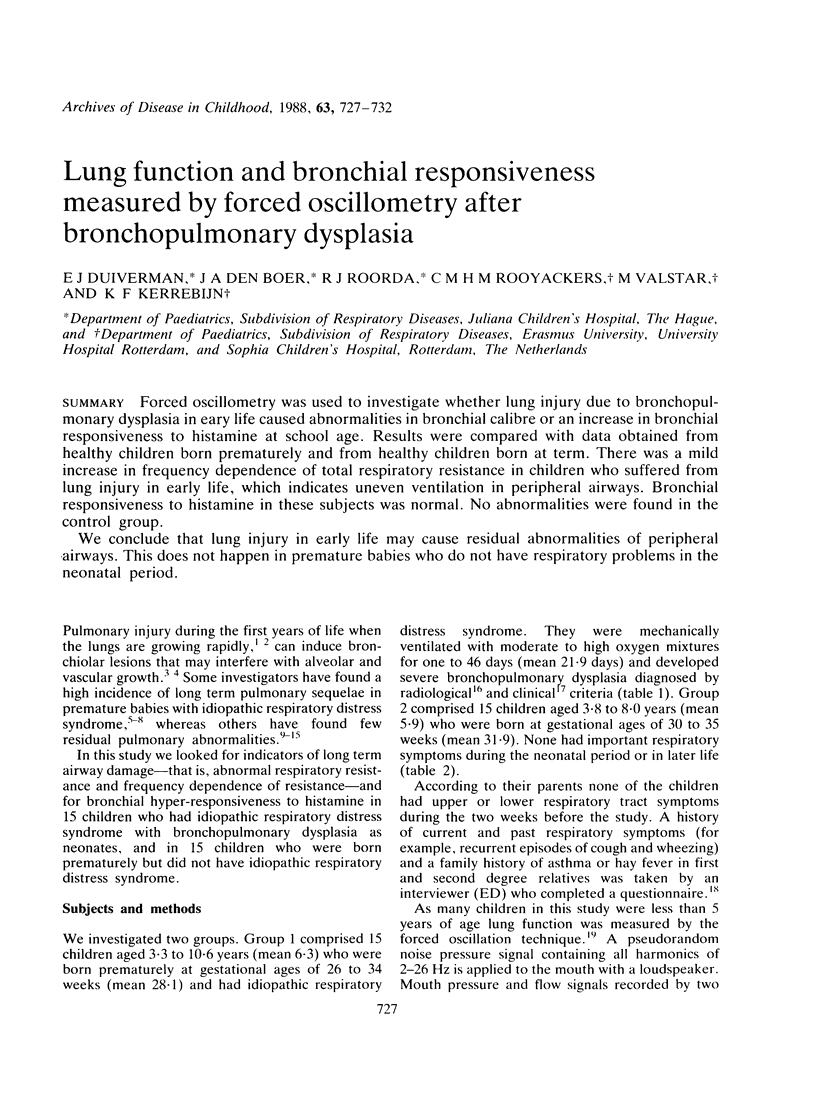
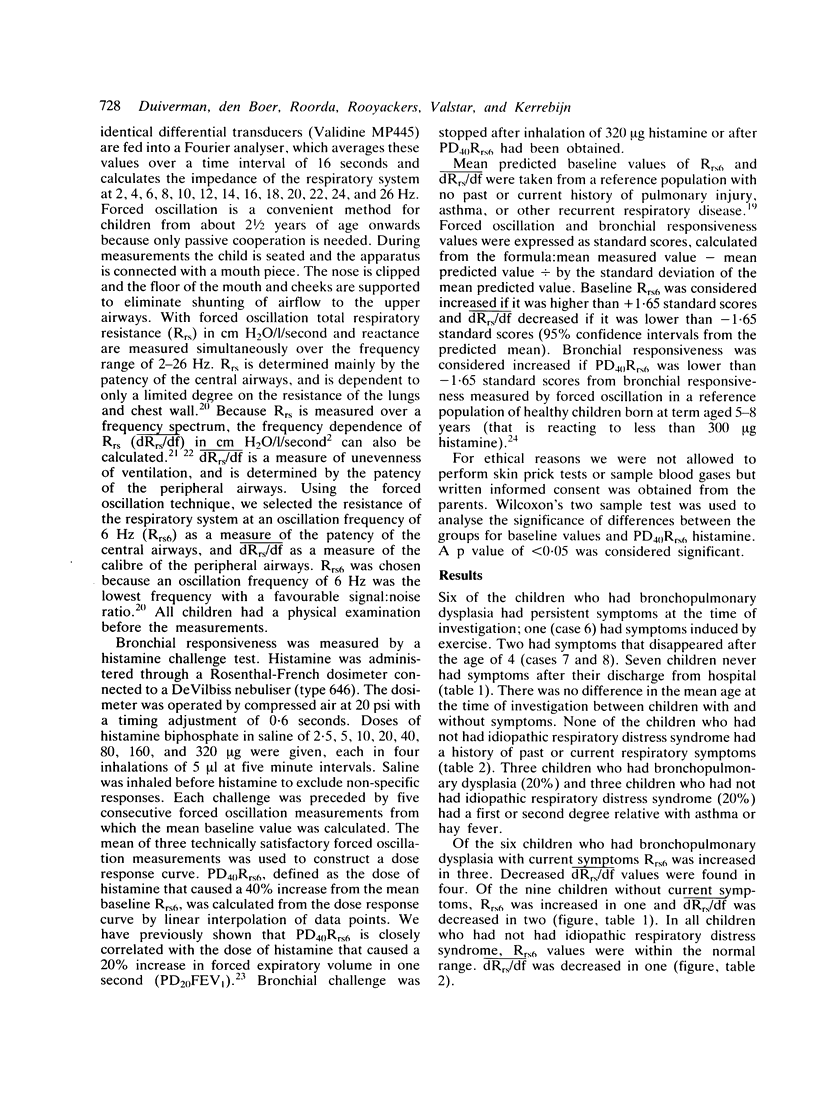
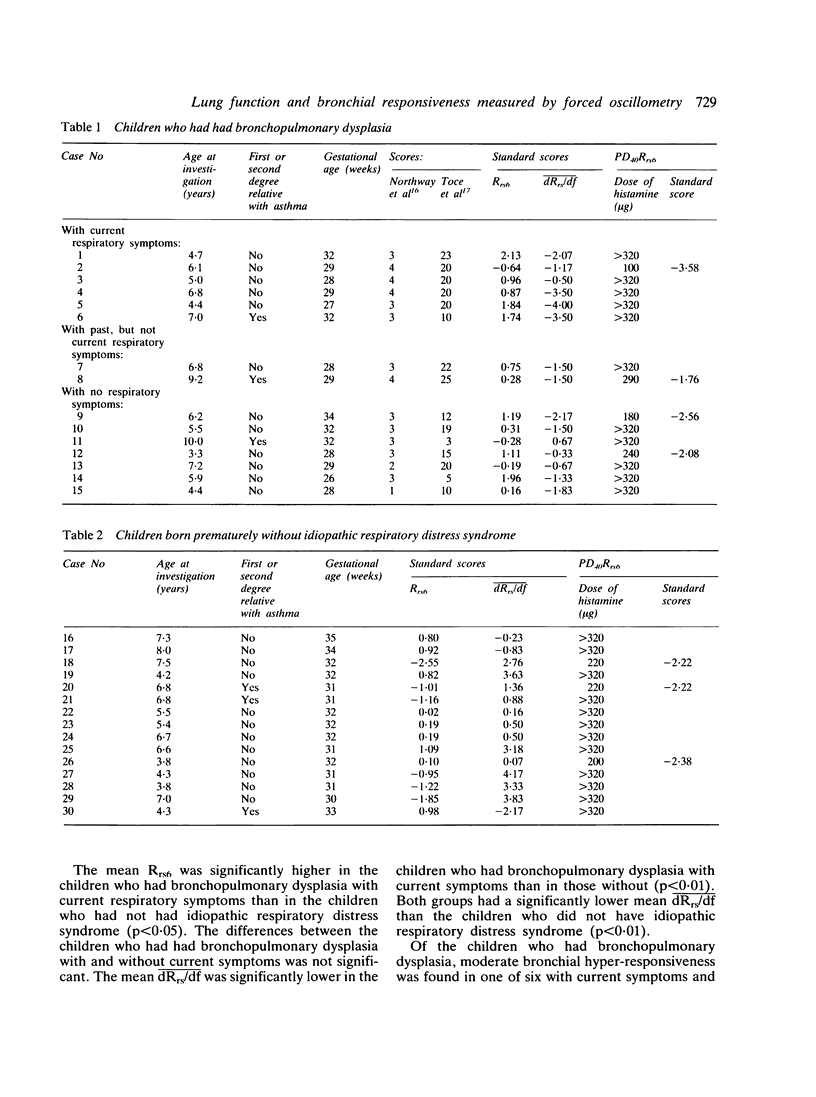
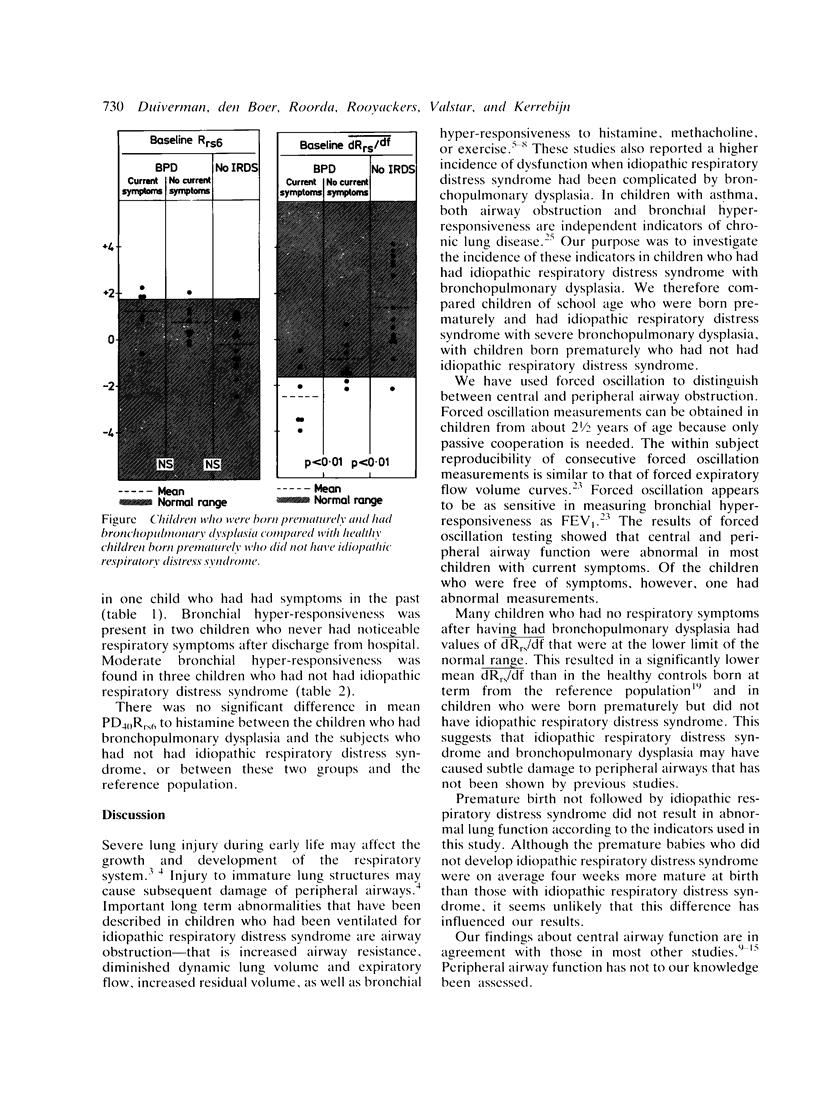
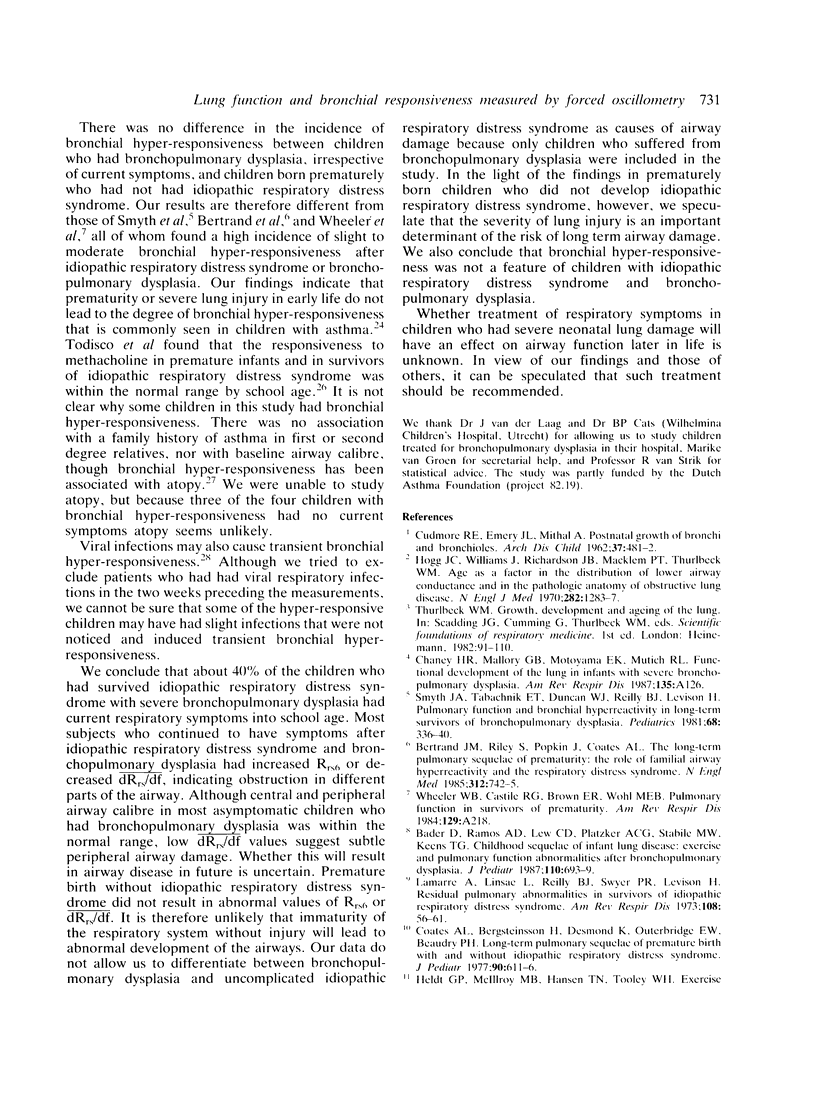
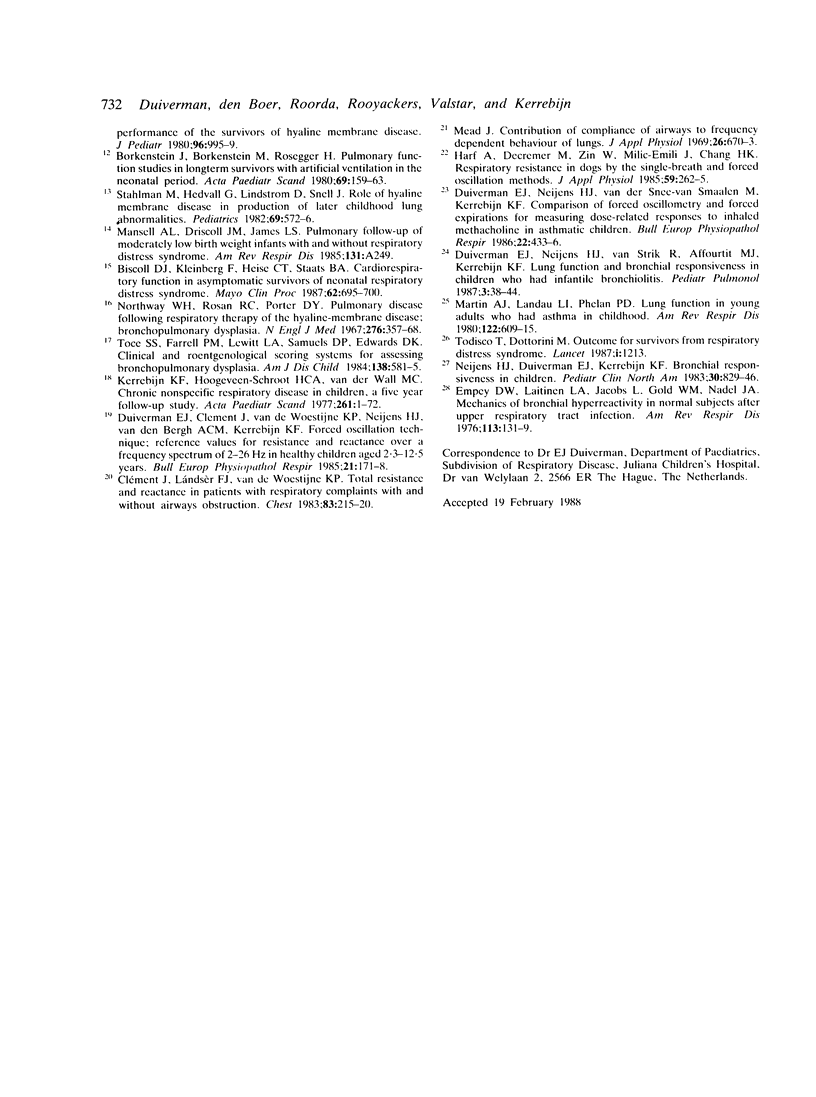
Images in this article
Selected References
These references are in PubMed. This may not be the complete list of references from this article.
- Borkenstein J., Borkenstein M., Rosegger H. Pulmonary function studies in long-term survivors with artificial ventilation in the neonatal period. Acta Paediatr Scand. 1980 Mar;69(2):159–163. doi: 10.1111/j.1651-2227.1980.tb07053.x. [DOI] [PubMed] [Google Scholar]
- Clément J., Làndsér F. J., Van de Woestijne K. P. Total resistance and reactance in patients with respiratory complaints with and without airways obstruction. Chest. 1983 Feb;83(2):215–220. doi: 10.1378/chest.83.2.215. [DOI] [PubMed] [Google Scholar]
- Driscoll D. J., Kleinberg F., Heise C. T., Staats B. A. Cardiorespiratory function in asymptomatic survivors of neonatal respiratory distress syndrome. Mayo Clin Proc. 1987 Aug;62(8):695–700. doi: 10.1016/s0025-6196(12)65222-7. [DOI] [PubMed] [Google Scholar]
- Duiverman E. J., Clément J., van de Woestijne K. P., Neijens H. J., van den Bergh A. C., Kerrebijn K. F. Forced oscillation technique. Reference values for resistance and reactance over a frequency spectrum of 2-26 Hz in healthy children aged 2.3-12.5 years. Bull Eur Physiopathol Respir. 1985 Mar-Apr;21(2):171–178. [PubMed] [Google Scholar]
- Duiverman E. J., Neijens H. J., Van der Snee-van Smaalen M., Kerrebijn K. F. Comparison of forced oscillometry and forced expirations for measuring dose-related responses to inhaled methacholine in asthmatic children. Bull Eur Physiopathol Respir. 1986 Sep-Oct;22(5):433–436. [PubMed] [Google Scholar]
- Duiverman E. J., Neijens H. J., van Strik R., Affourtit M. J., Kerrebijn K. F. Lung function and bronchial responsiveness in children who had infantile bronchiolitis. Pediatr Pulmonol. 1987 Jan-Feb;3(1):38–44. doi: 10.1002/ppul.1950030111. [DOI] [PubMed] [Google Scholar]
- Empey D. W., Laitinen L. A., Jacobs L., Gold W. M., Nadel J. A. Mechanisms of bronchial hyperreactivity in normal subjects after upper respiratory tract infection. Am Rev Respir Dis. 1976 Feb;113(2):131–139. doi: 10.1164/arrd.1976.113.2.131. [DOI] [PubMed] [Google Scholar]
- Harf A., Decramer M., Zin W., Milic-Emili J., Chang H. K. Respiratory resistance in dogs by the single-breath and the forced oscillation methods. J Appl Physiol (1985) 1985 Jul;59(1):262–265. doi: 10.1152/jappl.1985.59.1.262. [DOI] [PubMed] [Google Scholar]
- Heldt G. P., McIlroy M. B., Hansen T. N., Tooley W. H. Exercise performance of the survivors of hyaline membrane disease. J Pediatr. 1980 Jun;96(6):995–999. doi: 10.1016/s0022-3476(80)80624-x. [DOI] [PubMed] [Google Scholar]
- Martin A. J., Landau L. I., Phelan P. D. Lung function in young adults who had asthma in childhood. Am Rev Respir Dis. 1980 Oct;122(4):609–616. doi: 10.1164/arrd.1980.122.4.609. [DOI] [PubMed] [Google Scholar]
- Mead J. Contribution of compliance of airways to frequency-dependent behavior of lungs. J Appl Physiol. 1969 May;26(5):670–673. doi: 10.1152/jappl.1969.26.5.670. [DOI] [PubMed] [Google Scholar]
- Neijens H. J., Duiverman E. J., Kerrebijn K. F. Bronchial responsiveness in children. Pediatr Clin North Am. 1983 Oct;30(5):829–846. doi: 10.1016/s0031-3955(16)34468-6. [DOI] [PubMed] [Google Scholar]
- Northway W. H., Jr, Rosan R. C., Porter D. Y. Pulmonary disease following respirator therapy of hyaline-membrane disease. Bronchopulmonary dysplasia. N Engl J Med. 1967 Feb 16;276(7):357–368. doi: 10.1056/NEJM196702162760701. [DOI] [PubMed] [Google Scholar]
- Stahlman M., Hedvall G., Lindstrom D., Snell J. Role of hyaline membrane disease in production of later childhood lung abnormalities. Pediatrics. 1982 May;69(5):572–576. [PubMed] [Google Scholar]
- Toce S. S., Farrell P. M., Leavitt L. A., Samuels D. P., Edwards D. K. Clinical and roentgenographic scoring systems for assessing bronchopulmonary dysplasia. Am J Dis Child. 1984 Jun;138(6):581–585. doi: 10.1001/archpedi.1984.02140440065017. [DOI] [PubMed] [Google Scholar]



